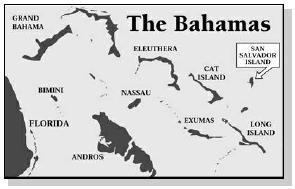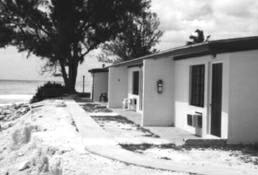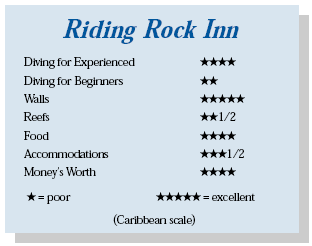Riding Rock Inn, San Salvador, BahamasContents of this Issue: Riding Rock Inn, San Salvador, Bahamas Oh Captain! my captain! our fearful trip is done! Boiling Seas, Bleached Coral, and Butt Cut Short s When Gold Doesn’t Glitter and Reynolds Wrap Won’t Do Stainless Steel Fails the Titanium Atomic Regulator Editorial Office: Ben Davison Publisher and Editor Undercurrent 3020 Bridgeway, Suite 102 Sausalito, CA 94965 where walls are the main attraction from the June, 2001 issue of Undercurrent
Dear Fellow Diver, I’m here to sing the praises of traveling alone. At least sometimes. You see, my spouse and I have been unable to find the time together to take a dive trip (though we’re about to head off to the Amazon). When she can get a week to go diving, I can’t. And vice versa. So I forego the comfort and fun of traveling with her and stay home, making myself miserable while I read about everyone else getting wet. But, in May, I decided I was big boy enough to venture out alone. You see, it has been 15 years since I went diving without her, my buddies or friends. Ignoring my fear of having dinner alone, I headed to the venerable Riding Rock Inn, about 200 miles southeast of Miami. Traveling alone to big city hotels is painless. Dial room service for truffle-stuffed partridge and a baked Alaska, then kick back and dine with Julia Roberts on HBO. Dive resorts are a different story. You’re lucky to get someone to fix the plumbing; let alone deliver a meal. Unless you’re bent, don’t even ask. So, you can hide behind a book in a corner of the dining room and watch the group from Tennessee laugh their way through dinner. Or, you can get adopted, which two couples, one from Cincinnati; the other from Manhattan, did for me. The five of us met for drinks and meals and I even got “mothered” a bit. One of the wives gave me an Advil and a cold beer while I sat at the pool. Of course, my wife would have done that, but alas, she was home with the dog. I shared a dive boat with these fine folks, but joyfully
ventured underwater alone. Although I signed a waiver
vouching that I would buddy dive, I told the divemaster I
came alone and would dive alone. “That’s cool,” he said. Riding Rock Inn is an adult place to dive. Their cozy bar’s festooned with driftwood and Styrofoam flotsam, on which everyone who has gone before writes that they partied here. Long-time dive shop manager Chris McLaughlin offered an informative and amusing briefing (aided by a thirsty crowd, most into their third beer and complimentary conch fritters) telling us, “We’ll take care of all your gear except your wetsuits -- you pee in them so we aren’t touching them ... the depth limit is 130 feet, but if you see a hammerhead having babies at 142 feet and a turtle is eating them, drop down and have a look ... just spend a little more time in the shallows ... go 175 feet and sit out for 24 hours ... we don’t check computers, but we’ll check you in and ask how deep you went.” My kind of place. Assigned to the same boat and crew for one’s entire stay, the draw gave me Captain Bruce and diveguide Alex (if you remember the late, late night comedian Sam Kinison, you might think Alex is the good twin). Alex was hard working and helpful. As I sat on the transom, he or Bruce would bring my tank, then steady me on the rocking boat until I stepped off. On my first dive at Shangri-La, I waited on the 45-foot bottom (no check out of any sort), and when Alex arrived I trailed along, as did a few others (many headed off on their own). As he kicked along, his neon green Force Fins (by George, some professionals do wear these things) made him easily visible. Shangri-La is typical of nearly every site, where the top of the wall is 40 or more feet. We slid over to 130 feet, into the not-so-blue water(the seas were up, it had been raining hard, the visibility hovered at 50 feet -- up to 80 later in the week). An exotic queen trigger emerged from a hole, cast one round eye on me, then continued his business.( I wondered whether homophobic divers realize they’re fraternizing with male queens). Below me, a sizeable porcupine fish hovered, and above, as the sun peeked through, the sheer and rugged wall rose into sparkling water. Alex stopped to point out an enormous lobster, wriggling his antenna to keep us at bay. Then, we headed up into the shallows where I saw a small turtle flit away as I burned off nitrogen.
Sand Castles was the second dive, along the wall at 70 feet, with plenty of coral features. At 40 feet, a solitary jack finned within a few feet, so close I could see little scratches on his body. A small Nassau grouper swam at me; as I reached out he slowed, allowing me to pat his side and scratch his belly. Then he rolled in the sand, as if to wash away my human scent. On these two dives, as on most, there were a few sponges and little soft coral. Most of the coral was covered with a leafy algae, giving the reef an a dark green hue. All in all, two typical dives, except for ...
Hammerheads. They’re a big reason people dive San Sal and sure enough I swam with a few, usually at a distance. At Orbit’s Canyon I dropped through a quiet and peaceful canyon, where a couple of curious black jacks circled. Then I emerged at 130 feet over a bright white sand bottom, which contrasted mightily with the deep blue sea and the landscape blackened from lack of light. After an awe-inspiring five minutes, enhanced nicely by the nitrogen spinning around my brain, a 6-foot hammerhead, lazed by 20 feet away. His eye combed the wall as he swivelled his head up and down. As I rose to 50 feet, a school of Bermuda chub ambled by. Nice dive. Yet, I found the algae-covered reef troublesome. Even when the sun appeared, much of the reef remained dull. Troubled by this, I contacted marine biologist Bill Alevizon, who wrote the Pisces Guide to Caribbean Reef Ecology. He told me, “I dove for two weeks at San Salvador in 1997 and the corals on the wall dives and elsewhere were clean. The algal infestation you are talking about appears to be widespread in the Bahamas now, and no one is sure why, although there are theories. At certain sites, there seems to be a tight correlation between Hurricane Floyd and the algal outbreak. My guess is that this is cyclical, and very likely related to the resuspension of nutrients that are normally trapped within bottom sediments. This happens over a broad area and at depths exceeding 60-70 feet during a major hurricane. The released nitrates and phosphates are sufficient to stimulate rapid algal growth. As these are used up and returned to the sediments in the ensuing years, the algae dies and coral cover expands again. Again, this is all very tenuous, but probably the most reasonable explanation. I saw the same thing at South Eleuthera this spring.” Well, good news someday, but not now. Floyd hit Riding Rock hard in September 1999, rendering the little waterside cottages uninhabitable. It took a month to get the resort open. Generally, the facilities are in decent shape, though neither the hotel nor the dive shop would pass a white glove test (nor on one day, a warm-water shower test). My room was on the end of one of two low rise motel-like structures, which had more light and better breezes than center units. It smelled horribly of stale cigarettes, but after a couple of days the smell of the sea took over. The tiled floor and screened louvered windows offered a bit of Caribbean ambiance, but the standard double bed, an air conditioner in the window, a cable TV (traveling alone, you get to flip channels till your heart’s content) high on the wall, an open closet, and a small bathroom rendered a 1980’s Holiday Inn-like touch. To take my notes, I sat either on the hide-a-bed couch or at the small table, peering out to the sea but 50 feet away. One afternoon I placed one of the few lounge chairs on a sand strip on the rocky shore. Or, after the afternoon dive I lounged at the pool with a cold Kalik, that good Bahamian beer. (Traveling alone, I polished off two thick books; with my wife, it would have been one book, several walks with her, and at least one good afternoon ride on the rental bikes.) In the main building housing the bar, office and dining room, the efficient staff served meals to groups of 4 to 18 at assigned tables. Strays could gather at their own community table or sit on the deck. Meals have a two-hour range, so you can steal in early or late to beat the crowd. I’d call the cuisine “good ole American grub,” the kind my mother, who opened lots of cans and boxes, might turn out on the weekend. Sometimes it was buffet, sometimes not. Breakfasts were All- American South, with grits, bacon or Jimmy Dean-like sausage patties, accompanying eggs, French toast or pancakes, with canned juices and fresh fruit. When lunch was sit down, it might be a hamburger or ham and cheese sandwich, with excellent fries. The alternatives were baked chicken with mac and cheese, stewed conch with rice and peas (beans to you), or chef’s salad loaded with meats and cheeses. A Mexican buffet lunch could have been catered by Taco Bell. A New Yorker who dines out in Tony restaurants five nights a week told me, “I love this lunch, but Taco Bell is even better.” Served dinners offered a different choice each night. Pork roast, a cut of beef -- not the prime rib advertised. Or grouper (but after I chucked one on the chin, I decided never to eat this fish again). Or perfectly cooked tuna. Or a buffet with prime rib, pork roast, coleslaw, beet salad, green salad. Or a chicken and rib barbecue. Steamed carrots, cauliflower or broccoli showed up at nearly every lunch and dinner. One night I opted for the vegetarian meal, a tasty stuffed squash. Barely drinkable jug Chablis (the label said “natural flavors”) comes with dinner, gratis. Desserts were from the cake, pie and ice cream section of your local supermarket. I speculated that only a Sumo wrestler could go hungry here -- and at more than one table there looked to be Sumo wrestlers -- but they didn’t leave hungry at all . It was wise to eat all you could, because strong winds kept the seas high and the boat rocky. To walk around, one needed ballast. Getting back on the boat could be a chore. During one safety stop, I watched the leaded decompression lines bob up and down so much that anyone who deigned to hang on could have been yo-yoed into an embolism. The surge would lift the boat transom out of the water, then slap it back down. Once, when I thought the surge had subsided, I rose to the ladder, removed my fins, grasped the ladder with one hand, and handed my fins up with the other. All of a sudden the boat pulled me high into the air, then dropped me down with a big thump. I was in a fury of bubbles, but immediately Alex was at my side, his wetsuit rolled around his waist, with no mask or fins, holding my tank. We bobbed to the surface. “Are you all right?” he asked. I said, “Fine, no problem.” He had worried the boat had landed on me and in a flash had jumped in to assure I was O.K. That’s good work, Alex. Of course, in those kinds of seas, divers need skills. Once Alex noted a weight belt on the deck and asked the remaining few divers if they had forgotten it. With no affirmative he said, “Well, we’ll soon find out won’t we?” Soon after, a diver surfaced for his belt. Alex handed it to him, telling him to drop to the sand bottom to put it on. “I can’t, I’ve never done that before,” he said. He then climbed up on the rocking boat, tank and all, slowing everyone’s entry. Who taught him? Another time, a diver tried to climb the ladder with his fins on -- until the surge flipped him off. Another climbed the ladder with his regulator out of his mouth and, when the surge knocked him back, took in a mouthful of water. His inflated BC kept him on the surface. While these conditions are apparently rare on San Sal, novice divers expecting a slam dunk must be aware. At Vickey’s Reef, we dropped down to 70 feet to swim among small Creole wrasses, blue chromis, fairy basslets and royal grammas. A 5- foot scalloped hammerhead appeared, swimming within ten feet, rolling his head as he kicked slowly along. On the reef top at 40 feet, a grouper at a cleaning station allowed photo buffs nose-to-nose shots. Behind the yard-high coral rim, a small nurse shark ambled on as I neared. Later, a shy queen angel swam up, four jacks paddled by, grouper hung at half a dozen cleaning stations, and garden eels everywhere seemed annoyed by pearly razor fish. These critters I had to find myself. Alex seems to envision his job simply as to show you the way -- he’ll get you through the many cuts and tunnels, then back to the boat, but hunting critters was your gig. That said, he’s a good guy and a skilled diver; guides like that are often fine by me. Riding Rock can power up as many as three dive boats; each can comfortably hold 15 divers (but groups load them with many more) while motoring up to 25 minutes to the sites. The dive shop is a bit disheveled (and the head on my dive boat didn’t work), but the staff produces. Tanks are filled to well over 3000 psi, the boats are prompt, you can hang your wet suits overnight to dry while leaving the other stuff on the boat. There are quick tank changes between dives. But, you better have a computer. Between the 130- and 70-foot dive it’s but a 30-minute surface interval, and not because they’re in a hurry to get back for lunch. It’s just the way they do things here -- maybe because there’s a chamber a mile down the road at the Club Med. (Before the third dive to 70 feet, it’s a three-hour interval.) While it’s easy enough to clear one’s computer entirely before leaving the water, I can’t imagine anyone in the industry recommending such a short interval (although they request a three-minute stop after the first dive and five minutes after the second). I often left with 1000 psi because, frankly, diving under the boat was usually the same old, same old. And, with the water running about 75 degrees, it got a little chilly. (Somewhat disconcerting, I might add, is that Bruce napped on at least two dives while divers were down. Why disconcerting? See the adjacent sidebar.) Besides the sheer walls and an occasional hammerhead, I thought the diving was pretty ordinary, due perhaps, to the algae cover. While on most dive trips, people climb out of the water exclaiming, “Did you see that (you name it)?” After the novelty of seeing hammerheads (or an occasional reef shark) wore off, the first comments were often, “Where did you go after we got out of the cut?” Or, “How much air did you have left? Or, “Did you see those turtles eat the baby hammerheads?” While I saw a queen angel or two on most dives, a few turtles, a couple of distant reef sharks and plenty of garden eels, there were no big schools of chromis, not a single eel (seen by me), only a couple of hogfish, an occasional school of grunts, and not much interesting macro. All in all, a population half of many other Caribbean venues. And while I passed on the night dive, my table mates returned sorely disappointed. Yet, I had a fine time. After all, three tanks a day means one can only spend 12.5 percent of 24 hours underwater. Sitting on the restaurant veranda with cup of coffee in the morning and a cold one at night was a great Alpha and Omega. The staff is helpful and friendly, especially Peaches. She would mix her deadly brews and as most every guest is a diver, there are endless tales to be heard at the bar. Although some people might say that there isn’t much to do here, I entertained myself all the time, especially when I consider the beautiful, uninterrupted naps. Next time I go diving, I’ll insist my wife come along. But, if she wants to stay home with the dog, I won’t hesitate to go it alone. And I’ll miss her a lot, just as I did at San Salvador -- but I’ll still have a good time. -Ben Davison P.S. And why with algae covered reefs and the relative paucity of fish do I give the RRI diving four stars? Because cruising a wall is one of the best experiences diving can offer. As DEMA’s slogan says, “It’s like nothing on earth.”
|

I want to get all the stories! Tell me how I can become an Undercurrent Online Member and get online access to all the articles of Undercurrent as well as thousands of first hand reports on dive operations world-wide
| Home | Online Members Area | My Account |
Login
|
Join
|
| Travel Index |
Dive Resort & Liveaboard Reviews
|
Featured Reports
|
Recent
Issues
|
Back Issues
|
|
Dive Gear
Index
|
Health/Safety Index
|
Environment & Misc.
Index
|
Seasonal Planner
|
Blogs
|
Free Articles
|
Book Picks
|
News
|
|
Special Offers
|
RSS
|
FAQ
|
About Us
|
Contact Us
|
Links
|
3020 Bridgeway, Ste 102, Sausalito, Ca 94965
All rights reserved.

 And
cool it was, as I went where I wanted, never needlessly worrying that my wife might get stuck in
a crevice (though as an instructor in an
earlier life she certified legions of
divers), or would need me to help her
buddy breathe if she got down to 500 psi
at 20 feet (although she’s made 2K dives,
about twice as many as I). Yes, I admit
to protective, irrational, even ridiculous
fears when I dive with her. Underwater,
she doesn’t worry about me, yet I torment
myself about her. But if I brought someone
else along, I’d never be a worrywart.
It must be in my genes.
And
cool it was, as I went where I wanted, never needlessly worrying that my wife might get stuck in
a crevice (though as an instructor in an
earlier life she certified legions of
divers), or would need me to help her
buddy breathe if she got down to 500 psi
at 20 feet (although she’s made 2K dives,
about twice as many as I). Yes, I admit
to protective, irrational, even ridiculous
fears when I dive with her. Underwater,
she doesn’t worry about me, yet I torment
myself about her. But if I brought someone
else along, I’d never be a worrywart.
It must be in my genes.

 Diver’s Compass: The
deluxe 8-day/7-night
package runs
$1,205/person, with
three meals, 18 dives,
taxes and gratuities.
Deluxe puts you in an oceanfront room,
worth the extra $105/person ... RRI
offers a Saturday charter flight to and
from Ft. Lauderdale; Bahamas Air flies
twice a day from Nassau, don’t expect
either airline to be on time ... Club
Med dive the same reefs. Thanks to the
Club, tap water everywhere is brackish;
they tapped the water table in 1992
when they opened, and drained it in
months; bottled water at the bar is
$3/gallon ... I found better airfares from San Francisco to Nassau then to Miami ...
In Nassau, I overnighted at the 265-year-old Graycliff, where waiters in white jackets
serve elegant meals in what is purported to be the only 5-star restaurant in the
Caribbean -- they make cigars on the premises, priced as high as $20 a smoke ...
From RRI, you can walk to tiny Cockburn town in 15 minutes or get a ride to buy a
$42 case of beer, cutting in half the $4/bottle charge at the bar; there are a couple
of local bars and tiny markets ... The package includes an interesting ‘roundthe-
island bus tour led by Snake Eyes, a local storyteller who spent much of the
three hours offering “proof” that San Salvador was Columbus’s first landfall ...
December through May can mean chilly waters; for some people, a 3 mm shorty was not
enough, so they rented more rubber ... Once a week the afternoon dive is replaced by
a night dive ... When the wind dies, sand fleas fly, targeting flesh below the
knees; bring DEET ... E-6 processing available; McLaughlin can scan the slides into
his computer for instant prints ...
Diver’s Compass: The
deluxe 8-day/7-night
package runs
$1,205/person, with
three meals, 18 dives,
taxes and gratuities.
Deluxe puts you in an oceanfront room,
worth the extra $105/person ... RRI
offers a Saturday charter flight to and
from Ft. Lauderdale; Bahamas Air flies
twice a day from Nassau, don’t expect
either airline to be on time ... Club
Med dive the same reefs. Thanks to the
Club, tap water everywhere is brackish;
they tapped the water table in 1992
when they opened, and drained it in
months; bottled water at the bar is
$3/gallon ... I found better airfares from San Francisco to Nassau then to Miami ...
In Nassau, I overnighted at the 265-year-old Graycliff, where waiters in white jackets
serve elegant meals in what is purported to be the only 5-star restaurant in the
Caribbean -- they make cigars on the premises, priced as high as $20 a smoke ...
From RRI, you can walk to tiny Cockburn town in 15 minutes or get a ride to buy a
$42 case of beer, cutting in half the $4/bottle charge at the bar; there are a couple
of local bars and tiny markets ... The package includes an interesting ‘roundthe-
island bus tour led by Snake Eyes, a local storyteller who spent much of the
three hours offering “proof” that San Salvador was Columbus’s first landfall ...
December through May can mean chilly waters; for some people, a 3 mm shorty was not
enough, so they rented more rubber ... Once a week the afternoon dive is replaced by
a night dive ... When the wind dies, sand fleas fly, targeting flesh below the
knees; bring DEET ... E-6 processing available; McLaughlin can scan the slides into
his computer for instant prints ... 